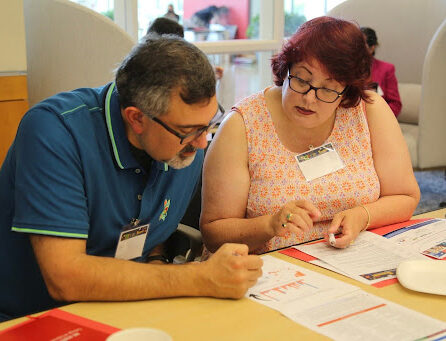By Jana Talley
ESTEEM II (Enhancing Data Science and Statistics Teacher Education--Transforming and Building Community) is a three-campus collaboration project funded through both NSF’s Noyce and IUSE programs. In the initial ESTEEM I project, the team integrated statistics content and pedagogy into undergraduate mathematics teacher preparation. The current project, ESTEEM II, is positioned to cultivate a highly engaged community of statistics and data science teachers and teacher educators. We chatted with two of the PIs to find out how they transitioned into the ESTEEM II project and how their work is enhancing the teaching and learning of data-rich subjects across the K-16 continuum.
Q: Could you remind us of the ESTEEM I project and how it has evolved into ESTEEM II?
The PIs on this project are Hollylynne Lee of North Caroline State University, Gemma Mojica of North Caroline State University, Stephanie Casey of Eastern Michigan University, and Rick Hudson of the University of Southern Indiana. At the onset of our collaboration, we recognized a widespread need for professional development resources for statistics teachers and teacher educators as the landscape of data science began to grow across the country and the world. Through the ESTEEM I project, tools such as learning modules, instructional videos, and CODAP (the Common Online Data Analysis Platform) were made available to participants as they constructed curriculum for preservice teachers. The ESTEEM I team provided training on how to use each tool to enhance the teaching and learning of statistics nationwide.
While the first iteration focused on developing statistics teacher educator resources and training instructors in their use, ESTEEM II was designed to (a) conduct research to better understand the problems of practice regarding teacher education, (b) extend the content focus beyond statistics to include data science, and (c) transform communities of teachers and teacher educators. Notably, the project team has cultivated online activities, facilitated a summer workshop, and constructed the ESTEEM Network website. To expand and support their network of educators, the site serves as an online platform for accessing materials, staying up to date with workshops, and connecting with like-minded educators.
Q: You mentioned CODAP. What exactly is CODAP?
The creators of CODAP designed it to be a dynamic, investigative tool to engage secondary students in exploring data. The free, web based tool gives students agency to interact with data sets, ask questions, and represent information graphically. The collaboration between CODAP and ESTEEM I/II supported further development of the online tool to not only make it more accessible, but to also align with easily digestible teacher preparation materials. The research component of ESTEEM II informs curriculum designs that embed the use of CODAP features, such as the sampler simulator, into data science and statistics teachers education courses.
Q: What strengths does your project gain from its collaborative structure?
Our team includes a host of highly qualified individuals that each bring unique talents to the project. Hollylynne and Gemma at North Carolina State University have extensive experience in statistics education and statistics teacher education as well as in creating online courses. These skills support the development of ESTEEM modules and videos. At Eastern Michigan University, Stephanie brings to the table many years of statistics high school teaching practice with deep roots in the AP statistics community. As a current professor of a data science and statistics course for teachers, Rick at the University of Southern Indiana is able to regularly use and evaluate the project materials. Naturally, the collaboration with Bill Finzer of the Concord Consortium has been an integral part of the incorporation of CODAP into our curriculum materials. We are additionally supported by two graduate students, an evaluator, and a program manager that ensure the project runs smoothly.
Q: How can those who are not participating in your project get involved with ESTEEM II?
A good place to start is the ESTEEM Network website, where educators collaborate to prepare secondary teachers for teaching data literacy, data science, and statistics. Not only does it provide a space for connecting with others, the ESTEEM resources can be found there for individual use. Resources like the instructional modules and videos are designed so that the user can decide how much or how little to incorporate into their classroom. For example, the foundational module is appropriate for someone with either little experience or not much time in the semester to address statistics or data science education. Users can choose to scale up from there as necessary. Also, by keeping educators abreast of upcoming events, The ESTEEM Network website, creates a space for continued growth in statistics education and data science education communities.
Author’s Note:
If you would like to know more about this NSF Project, Enhancing Data Science and Statistics Teacher Education--Transforming and Building Community (#2141727, 2141716, 213724), you can contact Hollylynne Lee (hollylynne@ncsu.edu), Gemma Mojica (gmmojica@ncsu.edu), Stephanie Casey (scasey1@emich.edu), or Rick Hudson (rhudson@usi.edu).

Jana Talley is a Co-Editor of DUE Point and an associate professor in the Department of Mathematics and Statistical Sciences at Jackson State University.
You can follow Jana Talley on:
